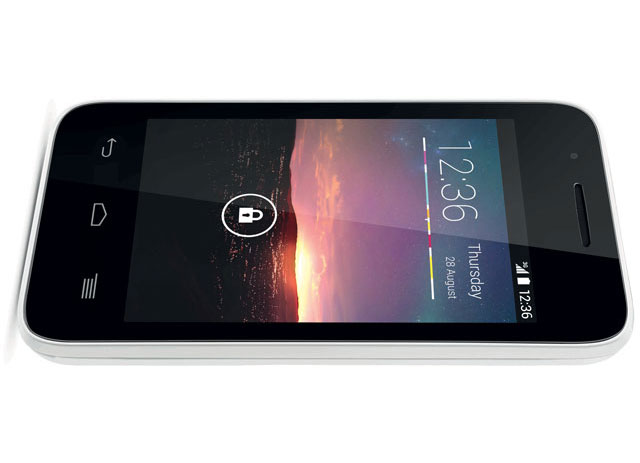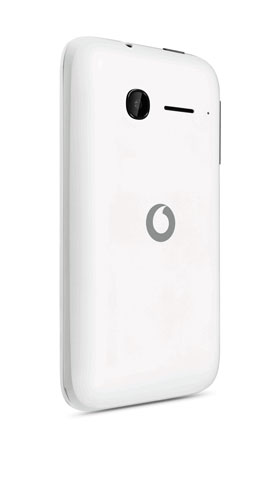
Vodacom launched the first US$50 smartphone on its network this week and, although the Smart Kicka, which retails for R549, is aimed at the low-end of the market that until now hasn’t been able to afford anything beyond a basic feature phone, it’s a surprisingly good device.
The Smart Kicka may not look like much at first. But for the price, it’s excellent for users that have never owned a smartphone before but who want to experience what such as device is capable of.
The launch of the Smart Kicka comes just weeks after Microsoft announced that it would discontinue Nokia’s popular Asha and S40 feature phones. Devices like this are likely to fill the gap.
The Smart Kicka is a small phone. It has a 3,5-inch LCD and the screen resolution is low. At 320×480 pixels, it delivers a pixel density of just 165ppi. It has 4GB of storage, but this can be expanded up to 32GB with a microSD card situated next to the Sim slot under the phone’s battery.
The battery has a rating of 1 400mAh and Vodacom claims 8,5h of talktime and standby time of 403h, both with the 3G aerial switched on.
There’s a low-quality, rear-mounted 2-megapixel camera, which will suffice for very basic snaps or even scanning QR codes. Not surprisingly, there is no front-facing camera.
The Kicka is powered by a 1GHz dual-core MediaTek processor and has 512MB of RAM — just enough to run Android and a few apps. At R549, one simply can’t expect more than that. We were surprised that the phone runs the very latest Android — 4.4 KitKat.
The phone is slow to use, to be sure, but not unusably so. Considering the target audience, this should be less of an issue, provided users stick to basic functions and simple apps and don’t try to install Angry Birds.
 During the initial setup of the Smart Kicka, it’s clear that Vodacom expects people who buy it to be those who’ve had no experience with Android or a smartphone before. The software provides tooltip-type information on almost every aspect of the device. For example, during the setup process, it tells users that the 3G icon will blink when the device uses data. It also shows the user that mobile data can be switched off.
During the initial setup of the Smart Kicka, it’s clear that Vodacom expects people who buy it to be those who’ve had no experience with Android or a smartphone before. The software provides tooltip-type information on almost every aspect of the device. For example, during the setup process, it tells users that the 3G icon will blink when the device uses data. It also shows the user that mobile data can be switched off.
The Smart Kicka supports 21Mbit/s downloads and 5,7Mbit/s uploads on 3G and uses the 900MHz and 2,1GHz bands for this. The 2G aerial uses 900MHz and 1,8GHz. Unfortunately, there’s no GPS — but, again, given the price, it’s not unexpected. Other connectivity options include Bluetooth 4.0 and Wi-Fi (802.11 b/g/n), ideal for making use of the many free hotspots that are popping up around South Africa.
An important feature for the South African market is the integrated FM radio. There’s also a set of headphones included with the phone.
Although the Android that powers the Smart Kicka does not feature any bloated user interface elements, Vodacom has included a number of its own apps, some of which are in fact just links the mobile website for Vodacom’s services. These include Cloud, allowing users to save their data on Vodacom’s servers, and Vodacom’s own app store that includes a number of free apps for users to download. Smart Kicka users still have access to Google’s Play store.
The Smart Kicka also comes bundled with the optional Vodafone Protect, a McAfee-powered security app to keep the phone protected from malware. Given that this phone needs every bit of power available to it, we don’t recommend installing it.
Facebook and Twitter, along with Google’s other bundled apps (Maps, Mail, Drive, YouTube, Hangouts, Chrome), are also preloaded.
Users who purchase the Smart Kicka receive bundled data in the form of three 50MB “power bundles”.
As the cheapest smartphone that we have reviewed, the Smart Kicka is seriously impressive. It works incredibly well considering its entry-level specifications. Over time, of course, users will become frustrated with the performance and demand a bigger and better phone. But it’s a great starting point and will get many South Africans online for the first time. Like any gateway drug, it will have served its purpose. — © 2014 NewsCentral Media




